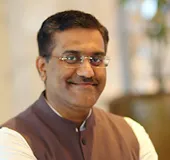
The conflict in Ukraine, western tech sanctions on the Russian aerospace industry and the consequent Russian defence production and supply chain difficulties have once again underscored the need to be self-reliant in the defence sector. India, the world’s third-largest military spender, accounted for almost 11 percent share of the global arms trade (2017 and 2021), primarily importing from Russia, Israel, and France. These arms imports reflect poorly on the Indian defence research ecosystem, which is yet to reach its full potential compared to the other major military powers. The government is undertaking a series of steps to boost the national R&D base by involving the private sector and start-ups. Fostering greater linkages with other countries’ defence R&D ecosystems and innovative funding mechanisms will facilitate these efforts and contribute to an expanded defence-industrial capability.
India’s struggles in defence research
The Defence Research and Development Organisation (DRDO) is India’s premier defence R&D entity, which acts as the central actor in the local development of new technologies. It has more than 50 laboratories and works with academic institutions (through Centres of Excellence), Defence Public Sector Units (like Hindustan Aeronautics Limited), national science and technology establishments (like Council of Scientific & Industrial Research), private sector, and international partners.
Fostering greater linkages with other countries’ defence R&D ecosystems and innovative funding mechanisms will facilitate these efforts and contribute to an expanded defence-industrial capability.
Despite this prominence, the DRDO has not entirely succeeded in producing adequately advanced technologies for use by the Indian military. The most famous example is the Arjun Tank, conceived in 1974 at a budget of INR 15.50 crores, but by the time the tank entered the service in 2004-05, its design had become outdated. Moreover, even though it was publicised as a ‘Made-in-India’ product, 69 percent of the Arjun tank’s components came from foreign vendors. And because it took so long to develop, the Indian Army had to buy T-90 tanks from Russia to make up for the shortfall in its armoured fleet. Several other examples illustrate the DRDO’s less than stellar performance (see Table 1).
Table 1: Current status of major DRDO projects
| Project |
Year of launch/sanction |
Current status |
| Astra Air-to-Air Missile |
2004 |
First generation Astra-Mk-1 went into production in 2017;
subsequently inducted into the Indian Air Force |
| Tejas Light Combat Aircraft |
1983 |
Received Final Operational Clearance in February 2019; first Indian Air Force squadron raised in 2016 |
| Arjun Main Battle Tank |
1974 |
Inducted in the Indian Army in 2004; next generation variants Mk-IA and Mk-II undergoing testing |
| Ballistic Missile Defence |
1999 |
Officials claim the programme is complete and are seeking approval of its deployment for Delhi |
| NAG Anti-Tank Guided Missile |
1983 |
Undergone multiple trials but yet to be inducted |
| Advanced Towed Artillery Gun System |
2013 |
Validation trials completed in 2022 |
Source: Authors’ research
While technology restrictions on India played their part in the delayed development of the local R&D ecosystem, it is also true that over the years, DRDO’s performance was characterised by cost overruns, poor project management, and subpar final results. Moreover, the lack of competitive peer entity and minimal participation from the academia and private sector reinforced DRDO’s hold over defence R&D. In contrast, academic institutions in the United States (US) proactively participate in defence research. The US government too encourages them by giving substantial funding support—as much as US$ 3.5 billion.
Government efforts to boost technology development
In recent years, the government has been slowly doing a course correction. This year, for instance, the union budget for FY 2022-23 has allocated Rs. 1200 crore for academic defence research. The budget also includes provisions to open up defence R&D and procurement to the private sector by giving 68 percent of the capital acquisition budget for purchasing from the domestic industry and 25 per cent of the defence R&D budget for the private sector, including start-ups. In addition, the DRDO’s Technology Development Fund, provides INR 10 crore funding to entities engaged in R&D in defence.
The iDEX’s Defence India Start-up Challenge (DISC) has given awards to start-ups based on their ability to devise solutions to specific military problems concerning encryption, communications, radar systems and unmanned platforms.
The government has also harnessed the start-up ecosystem through its Innovations for Defence Excellence (iDEX) programme, under the Defence Innovation Organisation (DIO), set up on the lines of the US’ Defense Innovation Unit, that works closely with the Silicon Valley. It works with R&D institutes, academia, business, start-ups, and individual innovators to develop technology solutions for the military by offering up to INR 1.5 crore in funding. Since 2018, the iDEX’s Defence India Start-up Challenge (DISC) has given awards to start-ups based on their ability to devise solutions to specific military problems concerning encryption, communications, radar systems and unmanned platforms. Many of these technologies are dual-use. For instance, one of the DISC winners, IROV Technologies’ underwater drone for observation and repair, also has a commercial application for the maritime sector and oil and gas companies.
It is evident that the government intends to stimulate other stakeholders’ participation in R&D.
Expanding the scope of defence R&D
The above steps will undoubtedly bring a change in India’s defence R&D ecosystem. In addition, the government will need to cultivate greater linkages with other countries’ R&D set-ups. India’s defence technology collaborations with the US and Israel have already begun this process. However, at present, these collaborations are confined to only government agencies. For instance, in September 2021, the India-US agreement to co-develop air-launched drones involves US’ Air Force Research Laboratory and DRDO. Aligning with the global trend, these tech collaborations must be expanded to include other stakeholders like academia, start-ups and the private sector, which will also help commercialise the technologies.
The India-US agreement to co-develop air-launched drones involves US’ Air Force Research Laboratory and DRDO.
Funding for R&D remains a pain point for India as its spending on R&D remains one of the lowest. This needs to be filled in by innovating new funding mechanisms to overcome the paucity of funds. According to Lok Sabha’s Standing Committee on Defence, India spends a measly 6 percent of the defence budget on R&D compared to China’s 20 percent and US’ 12 percent. Even the total share of general R&D expenditure as percentage of the Gross Domestic Product (GDP) is miniscule as compared to other nations.
Table 2: Research and development expenditure as % of GDP, 2020
| Nation |
Percentage of GDP |
| United States |
3.45 |
| China |
2.40 |
| Russia |
1.10 |
| Israel |
5.44 |
| Japan |
3.26 |
| UK |
1.71 |
| France |
2.35 |
| Germany |
3.14 |
| India |
0.66 |
Source: World Bank data from UNESCO Institute for Statistics
This is a significant weakness and a limitation too for the Indian defence planners as they face the challenge of the availability of resources to increase overall defence spending. Therefore, they will have to think creatively to increase spending on R&D. Encouraging the private sector to take up flagship tech development projects can be one way forward. However, this will entail the government to decrease barriers and give incentives to the private sector. One way to do is to perhaps open the management of DIO’s iDEX programme to the private sector.
Building a more competitive R&D ecosystem and focusing on emerging technologies remains the most definite way to achieve self-reliance in defence. The government has demonstrated its intent to expand the defence R&D ecosystem in India by initiating several policy measures. Active participation from the private sector and start-up ecosystem, which is cognisant of changing nature of warfare, will go a long way in building a national defence-industrial base and reducing dependence on arms imports.
The views expressed above belong to the author(s). ORF research and analyses now available on Telegram! Click here to access our curated content — blogs, longforms and interviews.




 PREV
PREV



